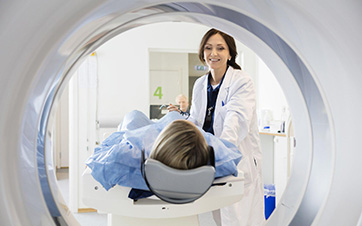
If you have been diagnosed with cystic pituitary adenoma, knowledge is key to addressing it effectively.
This guide empowers you with everything you need to know about these tumors to make informed decisions about your health.
What Are Cystic Pituitary Adenoma Tumors?
These are a specific subtype of pituitary tumors that contain cystic components. To better understand these tumors, it's important to explore the crucial role of the gland they call home-the pituitary.
The pituitary gland is a small, pea-sized organ located at the base of your brain, just behind the bridge of your nose. It's often called the "master gland" because it plays a crucial role in regulating the body's hormone levels. It produces and releases various hormones that travel throughout the body.
These hormones influence nearly every part of your body's functions, including:
- Growth
- Blood pressure
- Certain aspects of pregnancy and childbirth
- Breast milk production
- Sex organ functions in both men and women
- Thyroid gland function
- Metabolism
- Water and osmolarity regulation in the body
- The body's response to stress and injury
Pituitary adenomas, in general, are benign (non-cancerous) tumors that arise from the cells within the pituitary gland. What makes cystic adenomas unique is their fluid-filled center, differentiating them from their solid counterparts.
If this fluid occupies more than half the tumor's volume, it's classified as a cystic pituitary adenoma.
While cystic pituitary adenomas are typically slow-growing and rarely cause significant problems, their size can play a role. If they grow larger, they might press on surrounding structures, causing various health problems.
What Are the Most Common Cystic Pituitary Adenoma Symptoms?
Symptoms? It depends. In most cases, small cystic pituitary adenomas cause no trouble. But if they grow larger, they might press on nearby structures, leading to various brain tumor symptoms like:
Hormonal Imbalances
Depending on which cells in the pituitary gland the adenoma arises from, it can lead to overproduction of certain hormones, such as:
- Prolactin - causing galactorrhea and menstrual disturbances
- Growth hormone - leading to acromegaly in adults and gigantism in children
- ACTH - causing Cushing's disease
Large cystic pituitary adenomas can also result in underproduction of hormones. This can lead to conditions like hypothyroidism, adrenal insufficiency, and hypogonadism.
Headaches
The growing tumor can press on surrounding brain structures, leading to sudden, severe headaches. These can also be pesky and persistent, especially if the tumor nudges the nerves around your eyes.
Vision Problems
This is a particularly common symptom. Blurry vision, double vision, or even loss of peripheral sight can occur if the optic nerve gets squeezed.
General Symptoms
In addition to the above specific symptoms, people with large cystic pituitary adenoma tumors may exhibit various general symptoms. These include:
- Fatigue
- Weight gain or loss
- Excessive thirst or urination
- Difficulty concentrating
- Depression
- Sleep problems
- Skin changes
- Hair loss
Not everyone with cystic pituitary adenoma will experience all of these symptoms. Some people may have few symptoms, while others may have more severe symptoms. If you are experiencing any of these symptoms, it's important to see a doctor to get a diagnosis and discuss brain tumor treatment options.
How Is Diagnosis Done?
Early diagnosis of cystic pituitary adenoma can help prevent complications and improve the chances of effective treatment.
This often involves a series of clinical evaluations and diagnostic testing to identify and assess risk factors. Here's an overview of the various methods used:
Medical History and Physical Examination
The process begins with a thorough investigation of a patient's medical history, current symptoms, and lab test results. This step helps identify any factors that may suggest pituitary dysfunction, such as changes in vision, headaches, or symptoms related to hormone imbalances.
Imaging Tests
MRI-Magnetic Resonance Imaging-is an advanced technology for examining the pituitary gland and surrounding brain structures. It can provide detailed images that help identify the size, shape, and location of pituitary tumors.
Though less commonly used for pituitary tumors than MRI, a CT (Computed Tomography) scan can also help detect tumors and assess their effects on surrounding structures.
Blood Tests
These tests measure levels of various hormones in the blood. They aim to determine if the pituitary gland is producing too much or too little of certain hormones. The tested hormones depend on suspected pituitary dysfunction.
Urine Tests
For certain conditions, urine tests can help measure hormone levels that may be elevated due to a pituitary tumor. This is common when testing for Cushing's disease or acromegaly.
Vision Tests
Because of the pituitary gland's proximity to the optic chiasm, pituitary tumors can affect vision. A visual field test can help assess any loss of peripheral vision or other visual disturbances. An ophthalmologic examination may also be done to check the eyes for signs of pressure on the optic nerves, which can be caused by a pituitary tumor.
Like other types of brain tumors, the best approach to testing for a cystic pituitary tumor depends on the patient's symptoms, history, and the results of initial tests. A multidisciplinary team often works together to help develop an individualized treatment plan.
How Are Cystic Pituitary Adenoma Tumors Treated?
The treatment for cystic pituitary adenomas often depends on the size of the tumor, its impact on hormone levels, and the presence of symptoms. Common management strategies include:
- Careful monitoring to keep tabs on the growth of the tumor
- Medication to shrink the tumor or manage hormone levels
- Tumor removal surgery
In rare cases, radiation therapy may also be considered to help control the tumor's growth. Understanding cystic pituitary adenomas is crucial for the effective management of these tumors.
Connect With CTBTA to Get the Support You Need
A diagnosis of cystic pituitary adenoma can be overwhelming to receive, as it can raise concerns about potential changes in your life. It's important to acknowledge these emotions and remember that you're not alone.
At CTBTA, we offer brain tumor patients the support they need to navigate their diagnosis with confidence. We're here to listen, share experiences, and empower you.
Feel free to reach out to us today with your specific questions, messages, and concerns.
Disclaimer
All content and information on this website is for informational and educational purposes only and nothing herein shall be construed as medical advice. Always consult your medical provider for your particular needs and circumstances prior to making any medical decisions.

